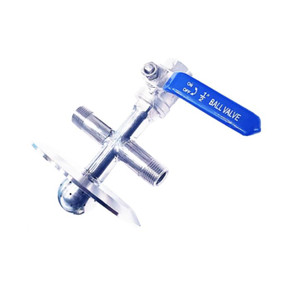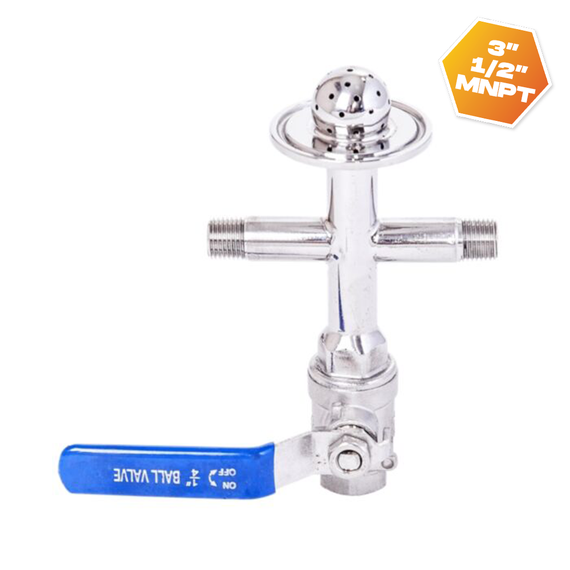
Botanical Health Oils Hardware Ltd
This inlet end cap valve is precision-machined from 304 stainless steel and includes an integrated shower head to evenly distribute fluid across the material column, helping to eliminate dry spots and ensure consistent flow.
It comes standard with a ¼” female NPT welded ball valve, also crafted from 304 stainless steel. Please note that a separate fitting is required to connect a hose to the valve—this can be purchased if not already on hand.
Users also have the option to attach a pressure gauge to monitor internal pressure within the material column during operation.
This unit is designed for use alongside a recovery tank. Its third port is a versatile connection typically used either for vacuuming the material column or introducing nitrogen into the system from the top.
Enables nitrogen-assisted processing
Supports vacuum evacuation directly from the material column
Nitrogen offers significant advantages in closed-loop fluid systems. It facilitates the transfer of liquids at subzero temperatures without requiring heat input to the recovery tank. This temperature control improves dewaxing performance and helps achieve a cleaner final extract.
At low temperatures, nitrogen builds up pressure in the system, so periodic venting is necessary. This can be done from the recovery tank or the base of the system.
Being able to vacuum from this point is especially beneficial during multiple-run workflows. It allows you to disconnect and reload the material column while recovery is still in progress—no need to disassemble the entire rig. This enhances operational efficiency and reduces downtime.
Once the column is reattached, it must be vacuumed again before use. This cannot be done from the base, which may contain residual oil or fluid. Instead, the vacuum should be applied from the hose running back to the recovery tank and through the material column, all the way down to the ball valve at the base.
This is vital for two key reasons:
Safety – Air trapped in the system can lead to pressure irregularities.
Purity – Moisture can condense inside the column when dry ice is applied, which may negatively affect filtration and overall extract quality.
This inlet end cap valve is precision-machined from 304 stainless steel and includes an integrated shower head to evenly distribute fluid across the material column, helping to eliminate dry spots and ensure consistent flow.
It comes standard with a ¼” female NPT welded ball valve, also crafted from 304 stainless steel. Please note that a separate fitting is required to connect a hose to the valve—this can be purchased if not already on hand.
Users also have the option to attach a pressure gauge to monitor internal pressure within the material column during operation.
This unit is designed for use alongside a recovery tank. Its third port is a versatile connection typically used either for vacuuming the material column or introducing nitrogen into the system from the top.
Enables nitrogen-assisted processing
Supports vacuum evacuation directly from the material column
Nitrogen offers significant advantages in closed-loop fluid systems. It facilitates the transfer of liquids at subzero temperatures without requiring heat input to the recovery tank. This temperature control improves dewaxing performance and helps achieve a cleaner final extract.
At low temperatures, nitrogen builds up pressure in the system, so periodic venting is necessary. This can be done from the recovery tank or the base of the system.
Being able to vacuum from this point is especially beneficial during multiple-run workflows. It allows you to disconnect and reload the material column while recovery is still in progress—no need to disassemble the entire rig. This enhances operational efficiency and reduces downtime.
Once the column is reattached, it must be vacuumed again before use. This cannot be done from the base, which may contain residual oil or fluid. Instead, the vacuum should be applied from the hose running back to the recovery tank and through the material column, all the way down to the ball valve at the base.
This is vital for two key reasons:
Safety – Air trapped in the system can lead to pressure irregularities.
Purity – Moisture can condense inside the column when dry ice is applied, which may negatively affect filtration and overall extract quality.

